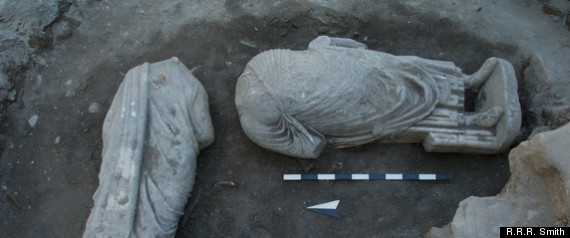By: Stephanie Pappas, LiveScience Senior Writer
Published: 09/18/2012 08:21 AM EDT on LiveScience

Two headless Roman statues have been discovered holding up a medieval-era platform in Turkey — an example of antiquities being reused by later generations as humble building material.
The ancient statues have lost their heads, but their clothing suggests that one was a representation of a local notable and the other an imperial office-holder, said R.R.R. Smith, who directs the New York University Excavations at Aphrodisias, an ancient Roman city in what is now Turkey. One statue dates back to about A.D. 200, while the other is from A.D. 450 or so. They were likely recycled by the 600s, Smith told LiveScience.
“Preliminary study of the pottery associated with the deposition of the statues suggests they were built into the platform already in the seventh century,” Smith said. “That is, in the immediately ‘post-antique’ early medieval period.”
Aphrodisias was near a marble quarry, and its statuary art flourished between about 30 B.C. and A.D. 600, during the era of the Roman Empire. Since 2008, Smith and his colleagues have been excavating “Tetrapylon Street,” a city boulevard that ran from the city’s sanctuary of the goddess Aphrodite to a major temple called the Sebasteion. The dig has turned up signs of what Smith called a “major conflagration” — collapsed columns, broken glass, fragmented mosaics and burned wood all in a chaotic mix. In August, archaeologists excavating above this layer of destruction found a built-up platform with two headless statues, positioned at a right angle from one another, used as a foundation. [See Images of the Statues and Dig Site]
The speaker and the governor
The near life-size statues probably lost their heads before they were repurposed as building material, Smith said. But even without faces, the statues tell a tale. The first, the one likely sculpted around A.D. 200, wears a cloak and tunic, the uniform of a notable citizen. The man was sculpted in a rhetorical posture, his right hand gesturing as if in mid-speech and his left hand grasping a carved scroll so detailed that the spiraling rolls of papyrus are visible.
via Headless Roman Statues Found In Turkey Show Antiquities’ Reuse.

Leave a Reply